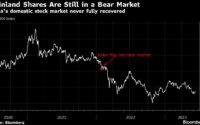White House Budgets for an Unrealistic Inflation Slowdown
(Bloomberg) — President Joe Biden’s proposed budget for the coming year is based on economic assumptions the White House itself recognizes are outdated, including a forecast for inflation to cool next year to about a quarter of its current, four-decade-high pace.
Most Read from Bloomberg
The economic projections were finalized in November, as is typical for the White House budget process. Since then, however, the economic outlook has altered significantly, with consumer-price inflation surging more than one percentage point, to 7.9% in the latest release — and that was prior to Russia’s invasion of Ukraine and gas prices hitting a record high.
Biden’s team anticipated a 4.7% inflation rate for this year, with 2.3% in 2023, rates that are notably below the median 6.2% and 2.6% forecasts of private economists compiled by Bloomberg.
A senior administration official acknowledged to reporters that the figures would be different if assembled today. The war is likely to increase pressure on food and energy costs this year, though price pressures will cool into the second half of the year, the official said. Later in the day, Council of Economic Advisers Chair Cecilia Rouse said updated forecasts will be prepared in a summer “mid-session update.”
“We do expect inflation to ease this year and into next year,” Rouse said at a White House briefing, citing anticipation for supply-chain snarls to ease over time.
Interest Rates
As for borrowing costs, three-month Treasury bill rates were penciled in at 0.2% this year — less than half their 0.52% current level. Ten-year Treasury yields are forecast at 2.1%; they were about 2.45% as of 12:21 p.m. in New York. Interest rates have been soaring in response to increasingly hawkish plans by the Federal Reserve to tighten monetary policy.
White House economic projections for growth and budget deficits are also more optimistic than expectations from the Federal Reserve. The White House pins real gross domestic product growth, an inflation-adjusted measure, at 2% or more for each year over the next decade.
But Fed policy makers say the longer-run U.S. growth pace is just 1.8%, according to the median economic projections from Fed governors and reserve bank presidents. The White House forecast for GDP to expand 3.8% this year is also more optimistic than the Fed’s 2.8% estimate.
The U.S. economy has recovered at a pace faster than most expected, including White House analysts. The economic boost was buoyed by more than $3 trillion in fiscal stimulus, which has since wound down following the immediate upheavals of the pandemic. Economists also say inflation will take a bigger bite out of the expansion given the impact of Russia’s Ukraine invasion.
Here are additional forecasts from the White House’s budget:
-
Unemployment rate of 3.9% this year, just above its current level, and between 3.6%-3.8% over the next decade. That’s just above the low reached before the pandemic.
-
Fiscal deficits sustained above $1.1 trillion over the next decade, hitting $1.8 trillion in 2032. The deficit as a share of GDP is forecast to average 4.7% in the next decade. That’s around 2019 levels, though notably above the ratios the U.S. enjoyed before former President Donald Trump’s 2017 tax cuts. The deficit was 2.4% of GDP in 2015.
(Updates with Rouse comments on inflation in fourth and fifth paragraphs. A previous version of this story was corrected to show CPI forecasts are below private-sector predictions, not above.)
Most Read from Bloomberg Businessweek
©2022 Bloomberg L.P.
[ad_2]
Source link


